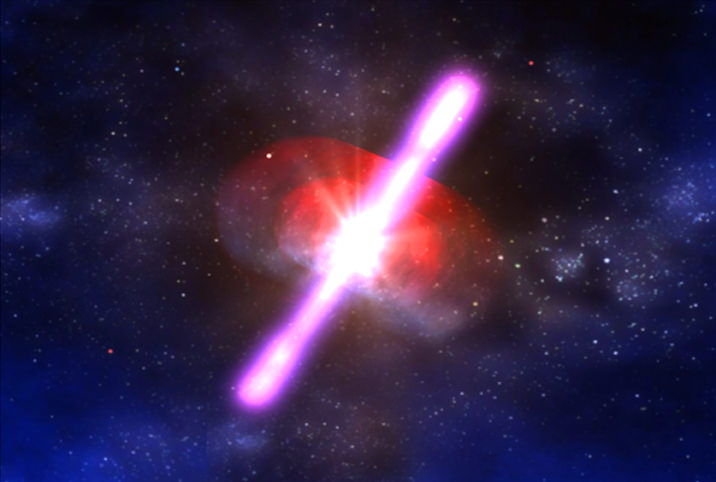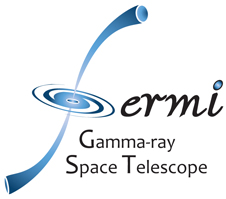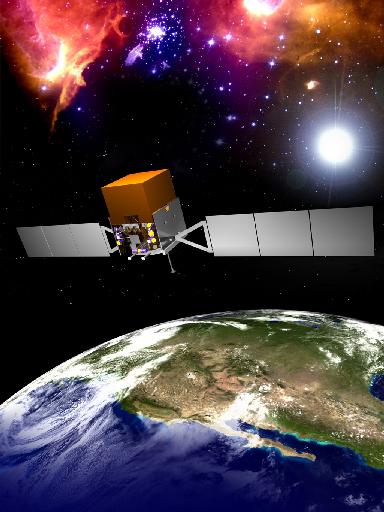This could be titled “87 Days of Fermi,” or “Blazing Galaxies:” This movie is made from the first 87 days of data gathered by Fermi’s Large Area Telescope (LAT), showing all the gamma ray sources detected so far, with active galaxies called blazars flaring and fading in this all-sky movie. “The movie shows counts of gamma rays seen by Fermi’s LAT, and each frame shows the gamma rays collected in one day,” said Elizabeth Hays, an astrophysicist on the Fermi team. Visible are rapid and dramatic flashes, which underscores one of the most valuable things Fermi does. “We watch the sky all the time and alert other telescopes, in space and on the ground, when something interesting is going on,” Hays said.
Continue reading “Now Showing: Fermi All-Sky Movie”
Integral Dissects Super-Bright Gamma Ray Burst
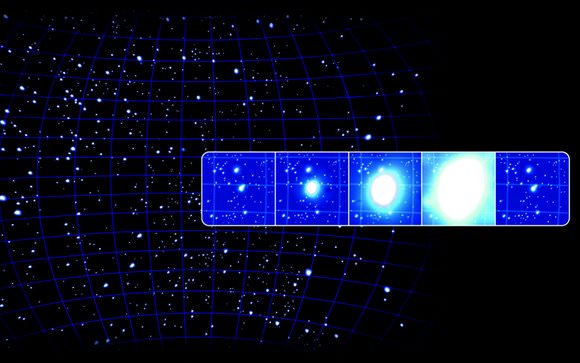
[/caption]
The European Space Agency’s Integral spacecraft has captured one of the brightest gamma-ray bursts ever seen. In looking at the data, astronomers have been able to investigate the initial phases of this giant stellar explosion, which ejected matter at velocities close to the speed of light. Astronomers also believe the explosion lifted a piece of the central engine’s magnetic field into space. The GRB reached Earth on December 19, 2004, and since then the Integral team has been meticulously dissecting the data.
Integral, an orbiting gamma-ray observatory, recorded the entire 2004 GRB event, providing information for what may prove to be one of the most important gamma-ray bursts (GRBs) seen in recent years. As the data was collected, astronomers saw the 500-second-long burst rise to extraordinary brilliance.
“It is in the top 1% of the brightest GRBs we have seen,” says Diego Götz, CEA Saclay, France, who headed the investigation.
The brightness of the event, known as GRB 041219A, has allowed the team to investigate the polarization of the gamma rays. Polarization refers to the preferred direction in which the radiation wave oscillates. For example Polaroid sunglasses work with visible light by letting through only a single direction of polarization, blocking most of the light from entering our eyes.
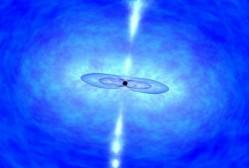
The team has shown that the gamma rays were highly polarized and varied tremendously in level and orientation.
The blast from a GRB is thought to be produced by a jet of fast-moving gas bursting from near the central engine; probably a black hole created by the collapse of the massive star. The polarization is directly related to the structure of the magnetic field in the jet. So it is one of the best ways for astronomers to investigate how the central engine produces the jet. Götz said there are a number of ways this might happen.
In the first scenario, the jet carries a portion of the central engine’s magnetic field into space. A second involves the jet generating the magnetic field far from the central engine. A third concerns the extreme case in which the jet contains no gas just magnetic energy, and a fourth scenario entails the jet moving through an existing field of radiation.
In each of the first three scenarios, the polarization is generated by what is called synchrotron radiation. The magnetic field traps particles, known as electrons, and forces them to spiral, releasing polarized radiation. In the fourth scenario, the polarization is imparted through interactions between the electrons in the jet and photons in the existing radiation field.
Götz believes that the Integral results favor a synchrotron model and, of those three, the most likely scenario is the first, in which the jet lifts the central engine’s magnetic field into space. “It is the only simple way to do it,” he says.
What Götz would most like to do is measure the polarization for every GRB, to see whether the same mechanism applies to all. Unfortunately, many GRBs are too faint for the current instrumentation to succeed. Even the state-of-the-art IBIS instrument on Integral can only record the polarization state of gamma rays if a celestial source is as bright as GRB 041219A.
“So, for now we just have to wait for the next big one,” he says.
Source: ESA
Swift Satellite Catches Early Stages of GRB
[/caption]
Astronomers have now been able to see the very early stages of a gamma ray burst, thanks to the Swift satellite. The Ultraviolet/Optical Telescope (UVOT) on board the satellite provided an ultraviolet spectrum of a GRB just 251 seconds after its onset – the earliest ever captured. Further use of the instrument in this way will also allow distance and brightness of GRBs to be calculated within a few hundred seconds of their initial outburst, as well as gather new information about the causes of bursts and the galaxies they originate from.
“The UVOT’s wavelength range, coupled with the fact that Swift is a space observatory with a speedy response rate, unconstrained by time of day or weather, has allowed us to collect this early ultraviolet spectrum,” said Martin Still from the Mullard Space Science Laboratory (MSSL) at UCL.
“By looking at these earlier moments of gamma ray bursts,” said Paul Kuin, another member of the team, “we will not only be able to better calculate things such as the luminosity and distance of a burst, but to find out more about the galaxies that play host to them and the impact these explosions have on their environments. Once this new technique is applied to much brighter bursts, we’ll have a wealth of new data.”
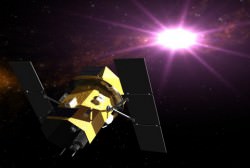
Massimiliano De Pasquale, a GRB scientist of the UVOT team, added, “The UVOT instrument is particularly suited to study bursts with an average to high redshift – a part of the ultraviolet spectrum that is difficult for even the very big ground-based telescopes to study. Using UVOT with Swift, we can now find redshifts for bursts that were difficult to capture in the past and find out more about their distant host galaxies, about ten billion light years away.”
Since its launch in 2004, the Swift satellite has provided the most comprehensive study so far of GRBs and their afterglows. Using the UVOT to obtain ultraviolet spectrums, the Swift team will be able to build on this study and even determine more about the host galaxies’ chemistry.
Paul Kuin said, “The new spectrum has not only allowed us to determine the distance of the gamma ray burst’s host galaxy but has revealed the density of its hydrogen clouds. Learning more about these far-away galaxies helps us to understand how they formed during the early universe. The gamma ray burst observed on this occasion originated in a galaxy 8 billion light years from Earth.”
Swift is a NASA mission in collaboration with the Science and Technology Facilities Council (STFC) in the UK and the Italian Space Agency (ASI). The work was published on Friday 27th February in the Monthly Notices of the Royal Astronomical society.
Source: Science and Technology Facilities Council
Fermi Glimpses Wildest-Ever Gamma-Ray Blast
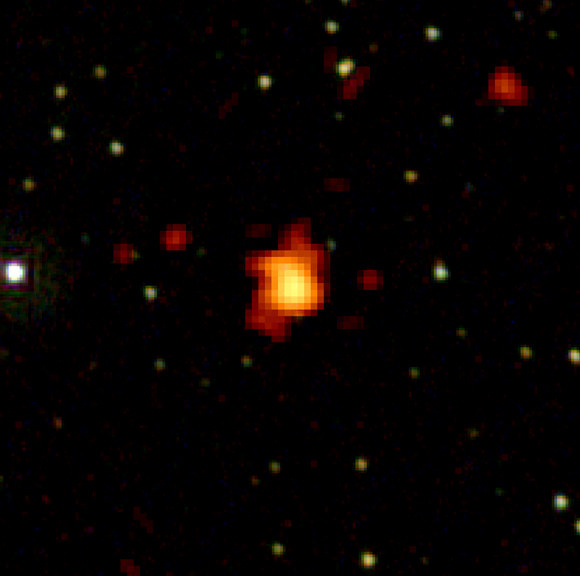
GRB 080916C’s X-ray afterglow appears orange and yellow in this view that merges images from Swift’s UltraViolet/Optical and X-ray telescopes. Credit: NASA/Swift/Stefan Immler
The collapse of very massive stars can produce violent explosions, accompanied by strong bursts of gamma-ray light, which are some of the brightest events in the universe. Typical gamma-ray bursts emit photons with energies between 10 kiloelectron volts and about 1 megaelectron volt. Photons with energies above megaelectron volts have been seen in some very rare occasions but the distances to their sources were not known. An international research consortium is reporting in this week’s issue of the journal Science Express that the Fermi Gamma-Ray Space Telescope has detected photons with energies between 8 kiloelectron volts and 13 gigaelectron volts arriving from the gamma-ray burst 080916C.
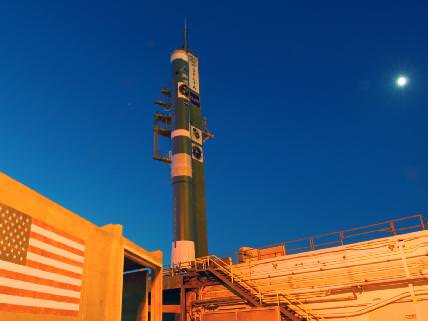
The explosion, designated GRB 080916C, occurred just after midnight GMT on September 16 (7:13 p.m. on the 15th in the eastern US). Two of Fermi’s science instruments — the Large Area Telescope and the Gamma-ray Burst Monitor — simultaneously recorded the event. Together, the two instruments provide a view of the blast’s gamma-ray emission from energies ranging from 3,000 to more than 5 billion times that of visible light.
A team led by Jochen Greiner at the Max Planck Institute for Extraterrestrial Physics in Garching, Germany, established that the blast occurred 12.2 billion light-years away using the Gamma-Ray Burst Optical/Near-Infrared Detector (GROND) on the 2.2-meter (7.2-foot) telescope at the European Southern Observatory in La Silla, Chile.
“Already, this was an exciting burst,” says Julie McEnery, a Fermi deputy project scientist at NASA’s Goddard Space Flight Center in Greenbelt, Maryland. “But with the GROND team’s distance, it went from exciting to extraordinary.”
Astronomers believe most gamma-ray explosions occur when exotic massive stars run out of nuclear fuel. As a star’s core collapses into a black hole, jets of material — powered by processes not yet fully understood — blast outward at nearly the speed of light. The jets bore all the way through the collapsing star and continue into space, where they interact with gas previously shed by the star. This generates bright afterglows that fade with time.
The burst is not only spectacular but also enigmatic: a curious time delay separates its highest-energy emissions from its lowest. Such a time lag has been seen clearly in only one earlier burst, and researchers have several explanations for why it may exist. It is possible that the delays could be explained by the structure of this environment, with the low- and high-energy gamma rays “coming from different parts of the jet or created through a different mechanism,” said Large Area Telescope Principal Investigator Peter Michelson, a Stanford University physics professor affiliated with the Department of Energy.
Another, far more speculative theory suggests that perhaps time lags result not from anything in the environment around the black hole, but from the gamma rays’ long journey from the black hole to our telescopes. If the theorized idea of quantum gravity is correct, then at its smallest scale space is not a smooth medium but a tumultuous, boiling froth of “quantum foam.” Lower-energy (and thus lighter) gamma rays would travel faster through this foam than higher-energy (and thus heavier) gamma rays. Over the course of 12.2 billion light years, this very small effect could add up to a significant delay.
The Fermi results provide the strongest test to date of the speed of light’s consistency at these extreme energies. As Fermi observes more gamma-ray bursts, researchers can look for time lags that vary with respect to the bursts. If the quantum gravity effect is present, time lags should vary in relation to the distance. If the environment around the burst origin is the cause, the lag should stay relatively constant no matter how far away the burst occurred.
“This one burst raises all sorts of questions,” Michelson says. “In a few years, we’ll have a fairly good sample of bursts, and may have some answers.”
Source: Eurekalert
Fermi, Swift spy outburst from gamma-ray star
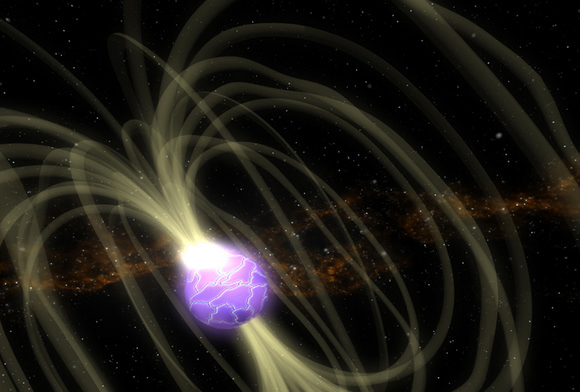
[/caption]
NASA’s Swift satellite and Fermi Gamma-ray Space Telescope have keyed in on a rowdy stellar remnant 30,000 light-years away. The object, already known as a source of pulsing radio and X-ray signals, lies in the southern constellation Norma. It kicked out some moderate eruptions in October, but then it settled down again. Late last month, it roared to life.
“At times, this remarkable object has erupted with more than a hundred flares in as little as 20 minutes,” said Loredana Vetere, who is coordinating the Swift observations at Pennsylvania State University. “The most intense flares emitted more total energy than the sun does in 20 years.”
The new object has been cataloged as SGR J1550-5418. Because of the recent outbursts, astronomers will classify it as a soft-gamma-ray repeater. Only six such objects are known to science, and they share the trait that they unpredictably send out a series of X-ray and gamma-ray flares. In 2004, a giant flare from another soft-gamma-ray repeater was so intense it measurably affected Earth’s upper atmosphere from 50,000 light-years away.
The source of the wild emissions is probably a spinning neutron star — the superdense, city-sized remains of an exploded star. Measuring only about 12 miles (19 kilometers) across, a neutron star is more massive than the sun.
While neutron stars typically possess intense magnetic fields, a subgroup displays fields 1,000 times stronger. These so-called magnetars have the strongest magnetic fields of any known objects in the universe. SGR J1550-5418, which rotates once every 2.07 seconds, holds the record for the fastest-spinning magnetar. Astronomers think magnetars power their flares by tapping into the tremendous energy of their magnetic fields.
Fermi’s gamma-ray burst monitor is designed to investigate magnetar flares, and SGR J1550-5418 has already triggered the instrument more than 95 times since Jan. 22. Swift’s X-ray telescope captured the first “light echoes” ever seen from a oft-gamma-ray repeater when SGR J1550-5418 started exploding. Both the halo-like rings and their apparent expansion are an illusion caused by the finite speed of light and the longer path the scattered light must travel. NASA’s Wind satellite, the joint NASA-Japan Suzaku mission, and the European Space Agency’s INTEGRAL satellite also have detected flares from SGR J1550-5418.
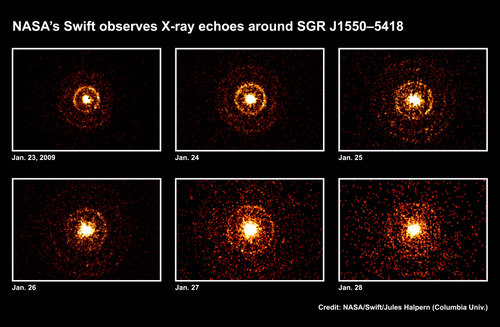
Old Space Observatory Spare Parts to Search for Dirty Bombs

[/caption]From 1991 to 2000, the Compton Gamma Ray Observatory dominated the search for the largest explosions ever observed in the cosmos: gamma-ray bursts (or GRBs). Unfortunately after nearly a decade of highly successful observations, June 4th 2000, NASA made the unpopular decision to de-orbit the observatory in response to a mechanical failure on the spacecraft (despite protests by some scientists, pointing out that the observatory could have continued operations).
To one scientist, Jim Ryan, the demise of the project he had tirelessly worked on since 1984 was a hard pill to swallow. However, in a surprise turn of events, the US Department of Energy tracked down Ryan and asked whether his research could be applied a little closer to home. In a flash of inspiration, the scientist realised spare parts left over from the Compton Gamma Ray Observatory could be used to pinpoint emissions from a potential “dirty bomb”, possibly providing security services with an early warning capability against a radioactive terrorist attack…
Although a dirty bomb has never been detonated and remain a speculative means by terrorists to cause maximum disruption to a populated area, the Department of Energy considers the threat to be very real. This is probably because a small amount of radioactive material could be used in the construction of a relatively cheap conventional bomb and plans by groups to use such weaponry have been uncovered in the past. The key power of a dirty bomb (otherwise known as a “radiological dispersal device”) isn’t the immediate health risk to a local population (apart from the obvious damage that could be caused by the conventional explosives used in the device), it is the lasting fear, panic and economic damage such a terror attack could cause. The residual radiation left over from a dirty bomb is of course a concern, but studies show that it is the psychological damage of such an attack that would have the greater effect.
So, the Department of Energy gave Dr Ryan a call to ask whether his work at the University of New Hampshire’s Space Science Center could be used to seek out radioactive devices. At the time, he was working on an instrument to be sent within the orbit of Mercury to detect low energy neutrons being emitted from the Sun. It just so happened that the neutron energy range matched that of the emission from plutonium.
“You don’t have to be an astrophysicist to see the connection,” Ryan commented on the government interest in using his techniques to search for nuclear devices on Earth.
However, during a visit to a National Guard exercise on Cape Cod, Jim Ryan was inspired by another space mission. The exercise carried out last year was to test security agent’s ability to track down dirty bombs (not nuclear weapons containing plutonium). Dirty bombs emit a different type of radiation (not the low energy neutrons emitted from a plutonium device), and Ryan realised that parts from his old and beloved Compton Gamma Ray Observatory may be resurrected to help serve national security tasks. Rather than manually scanning suspect radioactive devices with a hand-held Geiger counter, the gamma ray radiation can be detected at a safe distance and pinpointed. The problem with Geiger counters is that although they detect gamma radiation, you have to be standing right next to the radioactive source to know where it is. Using Compton Gamma Ray Observatory techniques can make the search safer and a lot more accurate.
“It lives on and does something that is useful to society as well as pure academic science,” Ryan said during a presentation to a Homeland Security conference in May. “[It is] poetic justice,” that the techniques by the spacecraft will be re-used by the modern fight against international terrorism.
Source: Boston.com
Gamma Ray Burst From the Edge of the Universe
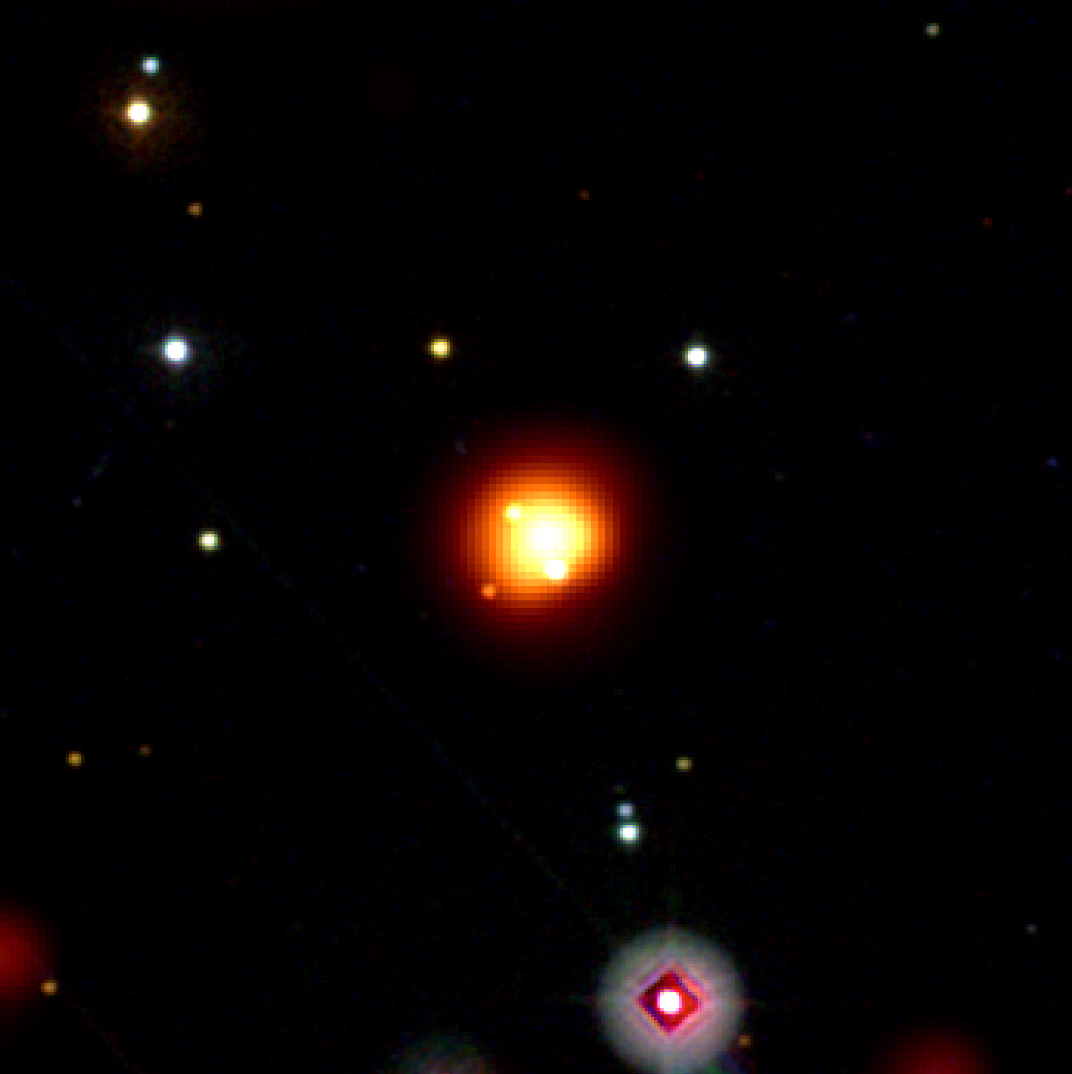
[/caption]
NASA’s Swift satellite captured the most distant gamma-ray burst ever detected. The blast came from an exploding star 12.8 billion light-years away, near the edge of the visible universe. Swift saw the explosion on September 13 at 1:47 am EDT. But because light moves at finite speed, and looking farther into the universe means looking back in time, this means the burst occurred less than 825 million years after the universe began, or when the universe was less than one-seventh its present age. This star was probably from the earliest generations of stars ever formed. “This is the most amazing burst Swift has seen,” said the mission’s lead scientist Neil Gehrels at NASA’s Goddard Space Flight Center.
Gamma rays from the far-off explosion triggered Swift’s Burst Alert Telescope, and the spacecraft established the event’s location in the constellation Eridanus. It quickly turned to examine the spot, and less than two minutes after the alert, Swift’s X-Ray Telescope began observing the position. There, it found a fading, previously unknown X-ray source. The burst has been designated as GRB 080913.
Astronomers on the ground were alerted as well and a group using ESO’s 2.2 meter telescope at the LaSilla Observatory were able to make observations one minute after Swift started observing. An hour and a half later, the Very Large Telescope at Paranal, Chile, targeted the afterglow.
Astronomers look for the redshift of these objects to determine distance. The light that is emitted from an object is shifted towards the red, or less energetic end, of the electromagnetic spectrum, due to the Doppler Effect. In certain colors, the brightness of a distant object shows a characteristic drop caused by intervening gas clouds. The farther away the object is, the longer the wavelength where this fade-out begins.
Analysis of the spectrum for GRB 080913 established the blast’s redshift at 6.7 — among the most distant objects known.
Gamma-ray bursts are the universe’s most luminous explosions. Most occur when massive stars run out of nuclear fuel. As their cores collapse into a black hole or neutron star, gas jets — driven by processes not fully understood — punch through the star and blast into space. There, they strike gas previously shed by the star and heat it, which generates bright afterglows.
Source: NASA
Blinding Gamma Ray Burst Was Directed at Earth
[/caption]
On March 19, 2008 at 2:13 am EDT, NASA’s Swift satellite detected an explosion from the constellation Bootes, and sent an alert to ground-based telescopes. At the same moment, the Russian KONUS instrument on NASA’s Wind satellite and a robotic wide-field optical camera called “Pi of the Sky” in Chile captured the first visible light from this incredibly bright and powerful gamma ray burst. Within the next 15 seconds, the burst brightened enough to be visible in a dark sky to human eyes. For a few moments, the GRB had a million times the luminosity of the entire Milky Way Galaxy. It briefly crested at a magnitude of 5.3 on the astronomical brightness scale. Incredibly, the dying star was 7.5 billion light-years away. Astronomers say the reason this gamma ray burst was so bright was that it was aimed almost directly at Earth.
Observations of the event, formally named GRB 080319B, are giving astronomers the most detailed portrait of a GRB ever recorded. “You have to have the satellites in orbit and the rapid response telescopes on Earth in order take complete advantage this rare kind of event,” said David Burrows, head of the Swift X-ray telescope team, at today’s press conference detailing the GRB.
Judith Racusin of Penn State University and a team of 92 coauthors report on observations across the spectrum that began 30 minutes before the explosion and followed its afterglow for months. The team concludes the burst’s extraordinary brightness arose from an unusual two component jet that shot material directly toward Earth at 99.99995 percent the speed of light.
Telescopes around the world already were studying the afterglow of another burst when GRB 080319B exploded just 10 degrees away.
Immediately after the blast, Swift’s UltraViolet and Optical Telescope and X-Ray Telescope indicated they were effectively blinded. Racusin initially thought something was wrong. Within minutes, however, as reports from other observers arrived, it was clear this was a special event. A head-on burst directed towards Earth only occurs by chance only about once a decade, so GRB 080319B is a rare catch.
Gamma-ray bursts are the universe’s most luminous explosions. Most occur when massive stars run out of nuclear fuel. As a star’s core collapses, it creates a black hole or neutron star that, through processes not fully understood, drive powerful gas jets outward. These jets punch through the collapsing star. As the jets shoot into space, they strike gas previously shed by the star and heat it. That generates bright afterglows.
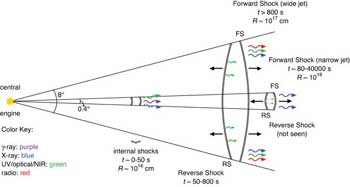
The team believes the jet directed toward Earth contained an ultra-fast component just 0.4 of a degree across. This core resided within a slightly less energetic jet about 20 times wider. “A normal signature is different from what we saw in this burst,” said Racusin . “In this object, we see two signatures of jets with two different properties.”
“Perhaps every gamma-ray burst has a narrow jet, but astronomers miss it most of the time,” says team member Stefano Covino. “We happened to view this monster down the barrel of the very narrow and energetic jet.”
These unique beacons of light were observed only 8 minutes after the trigger, and are the brightest bursts ever detected. Additional study of this event can also help provide more information on relativity and cosmology.
Burrows said if a similar event happened at our own galaxy, we would be in considerable trouble. “It’s been postulated that a nearby gamma ray burst directed at earth could affect our atmosphere, causing something like a nuclear winter. We are fortunate in that we don’t believe there are any stars in our galas that will produce a gamma ray burst.”
NASA, NASA News Audio
GLAST is Now Fermi
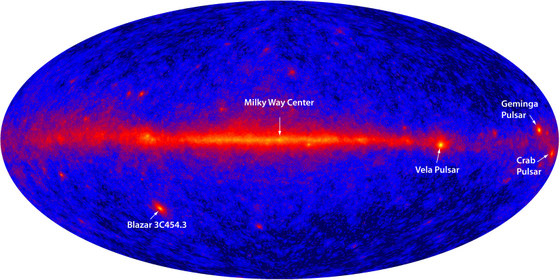
[/caption]
With “first light” successfully observed by the Gamma Ray Large Area Space Telescope, or GLAST, as it has been called until now, NASA has christened the space observatory with its new official name: The Fermi Gamma Ray Space Telescope. Named for Italian physicist Enrico Fermi, the telescope will delve into the mysteries of the high energy end of the electromagnetic spectrum. This new space telescope will try to determine what the mysterious dark matter is composed of, how black holes emit immense jets of material to nearly the speed of light, and help crack the mysteries of solar flares, cosmic rays and the power explosions called gamma ray bursts. At a news conference today to announce the new name and first light observations, Steve Ritz, Project Scientist for the telescope said scientists world-wide are very excited about the telescope’s breakthrough capability. “GLAST has great discovery potential. We’re expecting surprises,” he said.
Since the spacecraft’s launch on June 11, the project team has been busy turning on the spacecraft’s various subsystems and calibrating the instruments. GLAST was developed in cooperation with the US Department of Energy and international partners in France, Germany, Italy, Japan and Sweden. Over 100 international scientists are collaborating on this project. Fermi’s primary mission is for five years, with a goal of ten years of total operations.
The first image as seen above shows the bright gamma ray emissions in the plane of the Milky Way (center), bright pulsars and super-massive black holes. The Fermi Telescope saw in four days what a previous gamma ray mission, EGRET (Energetic Gamma Ray Experiment Telescope) imaged in nine years.
It also made detections of two active galaxies, and a blazar in the southern galactic plane, called 3C454.3, located about 7 billion light years from Earth, and a pulsar, called the Vela Pulsar located about 10 billion 1000 light years from Earth.
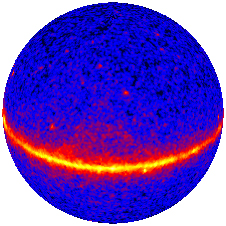
Video of Fermi’s first light detections.
The big advantage is Fermi’s huge field of view compared to previous gamma ray observatories. The entire sky is viewed about every two orbits or every 3 hours. Scientists say this is especially important because the gamma ray sky is constantly changing. With the telescope’s Burst Monitor, about one gamma ray burst has been detected every day from all areas of the sky.
Turning on the telescope has gone extremely smooth. “Everything worked as expected and then some,” said Ritz. “None of us could have asked for such a smooth turn on. It’s a credit to the world wide team of engineers, scientists, programmers and support people who all worked together as a seamless team over many years. It went like clockwork that went ahead of the clock. That doesn’t happen by accident. It was due to the great preparation work.”
Jon Morse from NASA’s Astrophysics Division calls the Fermi Telescope ‘The Extreme Machine’ and said to expect an exciting pace of new discoveries in the days and years ahead.
GLAST Science Operations Underway: Now, About That Name!
[/caption]
After a 60-day checkout period, science operations have begun in earnest for GLAST, the Gamma ray Large Area Space Telescope, which is now surveying the gamma-ray sky. Launched on June 11, 2008, the GLAST spacecraft has been undergoing calibrations of the two instruments on board, the LAT (Large Area Telescope) and the GBM (GLAST Burst Monitor) — more details on the instruments in a moment. But during the checkout phase both instruments made significant observations of gamma rays. “Given that these detections were made with just the engineering data observations, the future is full of promise, and we are very excited,” said Dr. Steve Ritz, GLAST Project Scientist in his GLAST blog. At the end of August, there will be a formal release of the first-light images taken by the spacecraft. Also at that time, NASA will rename the observatory. I don’t know about you, but I’m sort of attached to the name “GLAST.” But it will be interesting to find out its new, official name.
In June, LAT detected two extraordinarily bright, flaring sources in space, which scientists believe are very likely supermassive black hole systems at the cores of active galaxies, located far across the universe, but incredibly bright. Additionally, by the end of July, the GBM had detected 12 gamma ray bursts.
“We are thrilled to be detecting gamma-ray bursts so early in the mission. GLAST and the GBM are off to a great start!” said Charles “Chip” Meegan, GBM principal investigator at NASA’s Marshall Space Flight Center, Huntsville, Ala. “The detectors are working well and we’re really pleased with how the instrument is working. That said, we’re using this checkout period to scrutinize the data coming down from the detectors and fine tune flight and ground software and our daily operational processes.”
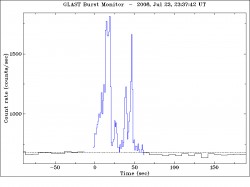
The LAT detects gamma rays and is able to make gamma ray images of astronomical objects. The GBM is designed to observe gamma ray bursts, which are sudden, brief flashes of gamma rays that occur about once a day at random positions in the sky. The GBM has such a large field-of-view that it will be able to see bursts from over 2/3 of the sky at one time. The observations made by GBM were verified by the Swift Telescope, another space telescope that can swiftly skew around to view a gamma ray burst.
NASA has a tradition of renaming spacecraft after a successful launch, and with GLAST they decided to wait until the “first light” images are released. Any guesses on what the new name will be?
Source: GLAST blog

